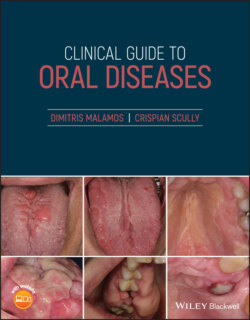Читать книгу Clinical Guide to Oral Diseases - Crispian Scully - Страница 20
Case 1.6
ОглавлениеFigure 1.6a
Figure 1.6b
CO: A 24‐year‐old male was referred for an evaluation of bleeding from his upper lip.
HPC: The hemorrhage appeared on his upper lip during eating from a broken bulla three hours ago.
PMH: This young man suffers from Down syndrome and over the last two years he has been complaining about multiple bullae on the skin of his legs, mouth, and genitals. He had a short course of steroid cream for skin bullae which was not effective, causing him to refuse any other medications since then.
OE: An anxious young man, showing numerous ulcerations inside his mouth, lips, and legs as a result of ruptured bullae due to friction. A hemorrhagic ulceration on his upper lip (Figure 1.6a) together with a tiny hemorrhage of the nail bed of his middle finger was found (Figure 1.6b). No other hemorrhagic lesions (petechiae or ecchymoses) were seen inside his mouth, skin or other mucosae. On the other hand, epistaxis was not referred and general symptomatology was absent. The patient was admitted to an examination, and blood results revealed no clotting disorders while biopsy of the skin revealed a subepithelial bulla with positive immunofluorescence of IgG and C3 along the basement membrane zone (BMZ).
Q1 What is the cause of his lip bleeding?
1 Self‐induced lip trauma
2 Pemphigoid disorders
3 Clotting disorder
4 Erythema multiforme
5 Herpetic stomatitis
Answers:
1 No
2 Pemphigoid bullous diseases (mucous and bullous) are a group of subepithelial bullous disorders which affect mainly the mouth (mucous type; or less frequently bullous type) or the skin. They have a characteristic immunofluorescence profile. Their bullae break easily and leave painful hemorrhagic ulcerations covered with hemorrhagic crusts as seen in this patient.
3 No
4 No
5 No
Comments: Clotting disorders are easily excluded from the diagnosis as the blood tests were negative. Herpetic stomatitis causes similar hemorrhagic oral lesions but is ruled out as this condition lacks chronic skin lesions and its severe mouth lesions occur only once and not constantly, as seen in this patient. Erythema multiforme shows similar findings with the patient's lesions, but is also excluded due to the short duration of its lesions and presence of fibrin instead of IgG and C3 with BMZ. Factitious illness is a problem in the disabled but not in Down syndrome patients, as these are less likely to develop maladaptive behavior and the patient did not show any aggressive behavior capable of causing self‐induced lesions in his body.
Q2 Which of the bullous disorders is/or are initiated with urticarial skin lesions?
1 Pemphigus vulgaris
2 Bullous pemphigoid
3 Cicatricial pemphigoid
4 Paraneoplastic pemphigus
5 Dermatitis herpetiformis
Answers:
1 No
2 Bullous pemphigoid is a chronic subepithelial blistering disease that starts as an urticarial eruption which develops large firm bullae, especially in flexor skin areas over a course of weeks to months.
3 No
4 No
5 Dermatitis herpetiformis is a chronic pruritic papulovesicular eruption which is associated with urticarial wheals and located symmetrically on the extensor surfaces of skin.
Comments: Although paraneoplastic pemphigus and cicatricial pemphigoid are chronic bullous disorders affecting oral and other mucosae and appear either as fragile intra‐epithelial bullae associated with a neoplasm (leukemia or lymphoma) or subepithelial bullae, they are never associated with pruritic rash and scarring.
Q3 Which lip conditions are presented with lip bleeding?
1 Exfoliate cheilitis
2 Erythema multiforme
3 Actinic prurigo
4 Granulomatous cheilitis
5 Perioral dermatitis
Answers:
1 Exfoliate cheilitis is a common cheilitis characterized by the production of keratin scales in the vermilion border of lips in young women with anxiety, who have the habit of removing the scales by rubbing them against their teeth thus leaving ulcerated hemorrhagic lesions.
2 Erythema multiforme is an acute mucocutaneous reaction characterized by erythematous plaques, painful hemorrhagic bullae and erosions in the skin (target like lesions), in the mouth and other mucosae. The presence of hemorrhagic crusts on the lips is pathognomonic for this condition.
3 Chronic exposure to solar radiation causes actinic prurigo, a photodermatosis affecting the skin, lips and conjunctiva. Lips are usually erythematous, scaly and in places bleed while the skin lesions appear as itchy, red papillae or nodules on cheeks, nose, forehead or arms, and eyes showing hyperemia, photophobia and pseudopterygium.
4 No
5 No
Comments: Perioral dermatitis is a chronic itchy papulopustular rash affecting the skin around the mouth while granulomatous cheilitis is a chronic, persistent swelling of lips due to granulomatous inflammations. Neither of them have a bleeding tendency.
